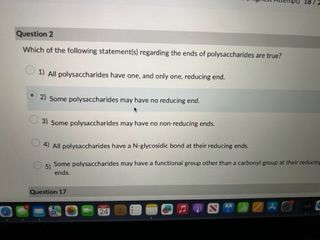

Polysaccharides are polymers of monosaccharides. Multiple monosaccharides get bonded to each other via glycosidic bonds to form polysaccharides. If all the glycosidic bonds in a polysaccharide are between the same two carbon atoms of monosaccharides, then the polysaccharide will be linear. For example, in amylose (a polysaccharide), the monosaccharides are linked to each other via glycosidic bonds between the C1 of one monosaccharide and the C4 of the next monosaccharide ( glycosidic bond to be specific). Therefore amylose is linear.
In glycogen however, the main chain is composed of monosaccharides linked via glycosidic bonds while branches arise as a result of
glycosidic bonds. Hence, glycogen is branched.
Polysaccharides have reducing and non-reducing ends. The reducing end is one with a monosaccharide with its anomeric carbon that is not involved in glycosidic bond formation. The nonreducing end has a monosaccharide whose anomeric carbon is involved in glycosidic bond formation. The anomeric carbon is the carbonyl carbon of the monosaccharide in its Fischer projection. The anomeric carbon of glucose is C1, while in fructose it is C2.
Trending nowThis is a popular solution!
Step by stepSolved in 3 steps with 3 images

- 27. Which correctly describes the furanose form of a monosaccharide? b) c) d) e) six-sided ring structure with five carbon atoms and one oxygen atom boat conformation of a monosaccharide, not the chair conformation linear structure of a monosaccharide, not the cyclic structure five-sided cyclic structure with four carbon atoms and one oxygen atom chemical derivatives of monosaccharides, such as amino sugars with an amino group attached In aqueous solution, monosaccharides such as glucose can exist as cyclic or linear structures. The percentage of monosaccharides that are in the cyclic form is: móre than 99 % b) 50 % 10 % d) 5% much less than 1% The monosaccharide structure shown here is: HOH,C он a) CH,OH но a-fructose b) c) d) e) B-ribose B-fructose a-galactose B-glucose HO Which of the molecules below is cellobiose, a breakdown product of cellulose? a) glucose-a-1,4-glucose glucose-a-1,2-fructose glucose-ß-1,4-glucose galactose-B-1,4-glucose glucose-a-1,6-glucosearrow_forwardPeptide bonds cannot rotate. This is because: a) the amino acid side chains are too bulky to allow this. B) Internal hydrogen bonding hinders rotation. C) interaction with water molecules hinders rotation D) the peptide bond has considerable double bond character Polypeptide chains prefer the trans conformation. This is because: a) This distances hydrophilic groups from hydrophobic groups b) this minimizes crowding of side chains c) This brings hydrophilic groups in contact with water molecules d) This allows proteins to fold more easily Ramachandran plots indicate that protein conformation is largely a function of: a) hydrophobicity b) number of amino acids c) torsion angles d) arrangement of prosthetic groupsarrow_forwarda)What Group? (Carb, Lipid, Protein, or Nucleic b)Acid). Within the group, how would you classify it? 1. Molecule #1 a) CH2OH H CH2OH b) H HỌ CH2OH он н он ÓH H c)How do you know you correctly classified this macromolecule in its proper group?arrow_forward
- What are the main biological functions of the polysaccharides?arrow_forwardAlthough the first two carbons of fructose and glucose are identical in structure to DHAP and GADP (from glycolysis), DHAP and GADP equilibriate on their in solution to favor the ketone over the aldehyde, while fructose and glucose do not. Why? a)The larger size of the molecule sterically hinders the isomerization b)The larger sugars have more OH groups which hydrogen bond and disrupt isomerization c)The larger sugars cyclize, and there is no carbonyl to isomerize in the cyclic form d)The larger sugars cyclize, and in the cyclic form the hydrogen bonding is very strong e)The larger sugars are less soluble in water than the smaller sugarsarrow_forward7. Consider the structures shown. For each structure select all that apply. a) pentose, hexose or heptose b) D or L c) ketose or aldose d) a or ẞ e) pyranose or furanose COOM CHACH Structure A Structure Carrow_forward
- 1. 2. List which carbohydrates are described as simple and which are complex? Briefly describe the general structures of monosaccharides, disaccharides, and polysaccharides (include the difference between starch and glycogen. Unbranched, occasional branching, and highly branched and how chemical structure effects function). Name the three monosaccharides considered to be important in nutrition, name the three disaccharides commonly found in foods and their component monosaccharides. Then name the foods these sugars are commonly found in (both mono and disaccharides).arrow_forwardBelow is Gulose in the open chain form: CHO H C-OH H C-OH HO C-H H- OH CH2OH Which of the following shows B-D-Gulose? A) B) CH2OH CH2OH OH ОН OH OH H H. OH OH H OH C) D) E) CH2OH H OH OH OH OH H CH2OH ČH2OH H H H. H. OH H. H. OH OH ÓH ОН H. -T -T I-arrow_forward
 BiochemistryBiochemistryISBN:9781319114671Author:Lubert Stryer, Jeremy M. Berg, John L. Tymoczko, Gregory J. Gatto Jr.Publisher:W. H. Freeman
BiochemistryBiochemistryISBN:9781319114671Author:Lubert Stryer, Jeremy M. Berg, John L. Tymoczko, Gregory J. Gatto Jr.Publisher:W. H. Freeman Lehninger Principles of BiochemistryBiochemistryISBN:9781464126116Author:David L. Nelson, Michael M. CoxPublisher:W. H. Freeman
Lehninger Principles of BiochemistryBiochemistryISBN:9781464126116Author:David L. Nelson, Michael M. CoxPublisher:W. H. Freeman Fundamentals of Biochemistry: Life at the Molecul...BiochemistryISBN:9781118918401Author:Donald Voet, Judith G. Voet, Charlotte W. PrattPublisher:WILEY
Fundamentals of Biochemistry: Life at the Molecul...BiochemistryISBN:9781118918401Author:Donald Voet, Judith G. Voet, Charlotte W. PrattPublisher:WILEY BiochemistryBiochemistryISBN:9781305961135Author:Mary K. Campbell, Shawn O. Farrell, Owen M. McDougalPublisher:Cengage Learning
BiochemistryBiochemistryISBN:9781305961135Author:Mary K. Campbell, Shawn O. Farrell, Owen M. McDougalPublisher:Cengage Learning BiochemistryBiochemistryISBN:9781305577206Author:Reginald H. Garrett, Charles M. GrishamPublisher:Cengage Learning
BiochemistryBiochemistryISBN:9781305577206Author:Reginald H. Garrett, Charles M. GrishamPublisher:Cengage Learning Fundamentals of General, Organic, and Biological ...BiochemistryISBN:9780134015187Author:John E. McMurry, David S. Ballantine, Carl A. Hoeger, Virginia E. PetersonPublisher:PEARSON
Fundamentals of General, Organic, and Biological ...BiochemistryISBN:9780134015187Author:John E. McMurry, David S. Ballantine, Carl A. Hoeger, Virginia E. PetersonPublisher:PEARSON





